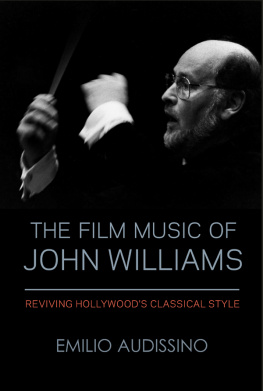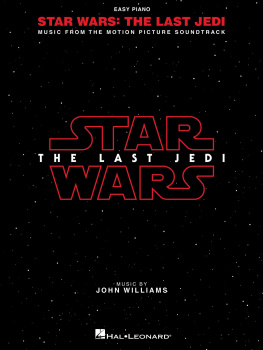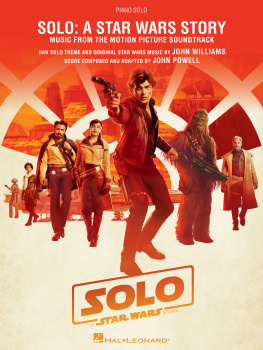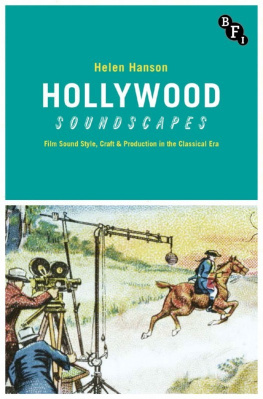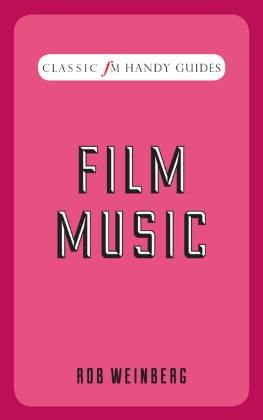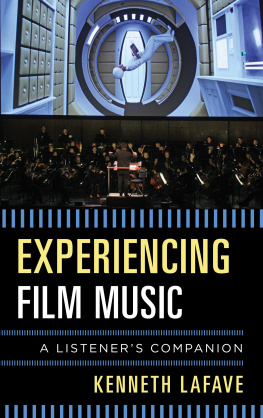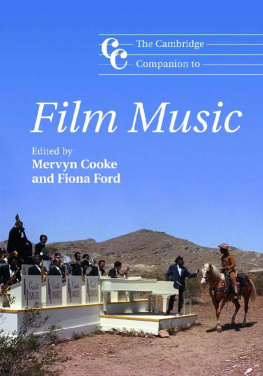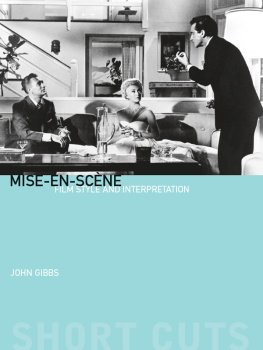WISCONSIN FILM STUDIES
Patrick McGilligan, series editor
The University of Wisconsin Press
728 State Street, Suite 443
Madison, Wisconsin 53706
uwpress.wisc.edu
Grays Inn House, 127 Clerkenwell Road
London EC1R 5DB, United Kingdom
eurospanbookstore.com
Originally published under the title John Williamss Film Music: Jaws, Star Wars, Raiders of the Lost Ark, and the Return of the Classical Hollywood Music Style, copyright 2014 by the Board of Regents of the University of Wisconsin System
Second edition copyright 2021 by the Board of Regents of the University of Wisconsin System
All rights reserved. Except in the case of brief quotations embedded in critical articles and reviews, no part of this publication may be reproduced, stored in a retrieval system, transmitted in any format or by any meansdigital, electronic, mechanical, photocopying, recording, or otherwiseor conveyed via the internet or a website without written permission of the University of Wisconsin Press. Rights inquiries should be directed to .
Printed in the United States of America
This book may be available in a digital edition.
Library of Congress Cataloging-in-Publication Data
Names: Audissino, Emilio, author.
Title: The film music of John Williams : reviving Hollywoods classical style / Emilio Audissino.
Other titles: John Williamss film music | Wisconsin film studies.
Description: Second edition. | Madison, Wisconsin : The University of Wisconsin Press, [2021] | Series: Wisconsin film studies | Originally published under the title John Williamss Film Music : Jaws, Star Wars, Raiders of the Lost Ark, and the return of the classical Hollywood music style, copyright 2014. | Includes bibliographical references and index.
Identifiers: LCCN 2020044532 | ISBN 9780299332341 (paperback)
Subjects: LCSH: Williams, John, 1932-Criticism and interpretation. | Motion picture musicHistory and criticism.
Classification: LCC ML410.W71335 A83 2021 | DDC 781.5/4213092dc23
LC record available at https://lccn.loc.gov/2020044532
ISBN-13: 978-0-299-33238-9 (electronic)
To the many friends who have put up with me in the past forty years, especially my marvelous and marvelously patience-endowed family.
Grazie, vi voglio bene.
There is nobody in my experience who made the kind of impact on my career and my films than this man. This man has absolutely transformed everything that I have done into something that I could not imagine ever having done. And he does it because he communicates so well with all of you. He has rediscovered something that was very popular and important in the 1930s and 1940s.... And I know of no one who knows how to write film music that goes straight to your heart and straight to your soul than my good friend John Williams.... And John is actually one of the greatest storytellers of all time.
STEVEN SPIELBERG, Hollywood Bowl Hall of Fame Ceremony, 23 June 2000
The great thing about John is this: Composer equals maestro. Maestro equals ego. John never writes his score. He writes the movies score. Hes not doing the work to aggrandize himself. Hes doing it to make the movie as good as it possibly can. You dont find that very often.
GEORGE LUCAS, USC John Williams Scoring Stage dedication ceremony, 26 April 2011
Hes such a generous person and hes such a humble person too. He respects his musicians so that they give 150% to him all the time. And honesty. That is what we have in his music. That is why we have connected to all of these melodies from all of his great films.
GUSTAVO DUDAMEL, American Film Institute Life Achievement Award to John Williams, 9 June 2016
Illustrations
Photographs
Figures
Acknowledgments
There are many people who have accompanied me throughout the preparation of the first edition of this book. I seize the occasion of this second edition to reiterate my appreciation to those whose support has proven unabated and to add mentions of those friends and colleagues I have met between the first and this second edition. The majority of the research for the preparation of this book was conducted in the (now defunct) Dipartimento di Storia delle Arti at the University of Pisa, Italy, where I completed my first PhD. Special mentions go to Alessandra Lischi and Cinzia Maria Sicca Bursill-Hall.
Part of this book is based on fieldwork carried out in Boston, Massachusetts. On the one hand, it consisted of my regular presence at all John Williams concerts with the Boston Pops from 2007 to 2013. On the other hand, it consisted of archival research at the Boston Symphony Orchestra Archives and at the WGBH Educational Foundation Media Library and Archives. Many thanks for their advice and assistance go to Bridget P. Carr and Barbara Perkel (BSO Archives) and to Keith Luf, Nancy Dillon, and Leah Weisse (WGBH Archives). My warmest thanks go to my dear friends in Boston and at Bostons Symphony Hall, Doreen M. Reis, Vincenzo Peppino Natale, and Adam Castiglioni, for their constant friendship and support. A special tip of the hat goes to radio legend Ron Della Chiesa, not only for his friendship and in fond memory of our conversations about the history of the Boston Symphony Orchestra and the Boston Pops but also for being the host and presenter at the book launch in June 2014 at Bostons Prudential Center. A special acknowledgment also goes to my Bostonian friend Victor Brogna, who lent a very helpful hand both with legal issues and with the proofreading of the first edition.
My friend John Norris deserves my warmest gratitude and a central niche of his own. He is a thorough connoisseur of film music and John Williamssworks and was an invaluable assistant in my archival research in Boston. He was also my eyes and ears at those concerts that I was not able to attend. At the concerts I was able to attend, he and his wife, Christine Dehil, have been my delightful companionsand the photographers of my meetings with the Maestro. More friends have more recently shared with me some Williams experiences, and we regularly entertain exchanges about the latest news from the Williams universe. To them and their partners goes my friendliest ciao: Simone Pedroni and Elisa Petrarulo, and Maurizio Caschetto and Ilaria Ruffoni.
The updates and revisions of the book have matured during my stay at the University of Southampton, UK, where I had the opportunity to present lectures and classes on Williamss music during the years. My sincerest appreciation goes to my mentor Kevin J. Donnelly and to the other colleagues I worked with there: Tim Bergfelder, Beth Carroll, Mike Hammond, Sally Keenan, Lucy Mazdon, Paola Visconti, and Michael Williams.
I would also like to mention Cynthia Wilson and Emile Wennekes (Utrecht University, the Netherlands), who have always shown a true appreciation of my book: we got acquainted as colleagues, to soon become collaborators on many projects and, most importantly, friends. Dank je wel, Cynthia en Emile!
As to the form and appearance of the book, I wish to express my appreciation to the many people who gave their contributions at the various stages of the process, from the first version of the manuscript back in 2013 to the 2021 second edition. First, Im grateful to the University of Wisconsin Press for giving me the opportunity to bring this book to fruition. For the first edition, I reiterate my sincere gratitude to Executive Editor Raphael Kadushin, to his assistant Matthew Cosby, and to all the nice persons I worked with at UW Press: Andrea Christofferson, Sheila Leary, Carla Marolt, Sheila McMahon, Adam Mehring, and Elena Spagnolie. For this new edition, I am grateful to UW Press director Dennis Lloyd for asking me to return to the drawing board to update and expand the book for a new release, to Jacqulyn Gaik-Ing Teoh for her assistance, and to Sheila McMahon for outstanding copyediting work. Acknowledgments for the cover design of this new edition go to Jennifer Conn and the marketing and art-direction staff at UW Press. My thanks also go to the late George Burt, and to Vincent LoBrutto, Jeff Smith, and Larry Timm, who read the manuscript in its first version, and to Kevin Donnelly and Emile Wennekes, who read new parts of this current versionthe Closing Remarks and For their competent legal advice on US copyright law and on the fair use doctrine, my deepest appreciation goes to attorneys-at-law Redenta Enne and Bill Lee. As for the visual part, my appreciation goes to Mrs. Samantha Winslow Williams for generously giving her permission to feature her exquisite John Williams portraits, of which the one that closes the book perfectly captures the Maestro at work and his piano-and-pencil modus operandi.

